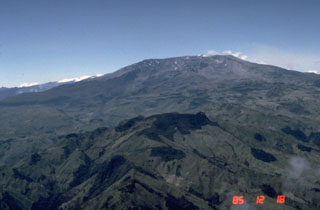Report on Nevado del Ruiz (Colombia) — 16 July-22 July 2025
Smithsonian Institution / US Geological Survey
Weekly Volcanic Activity Report, 16 July-22 July 2025
Managing Editor: Sally Sennert.
Please cite this report as:
Global Volcanism Program, 2025. Report on Nevado del Ruiz (Colombia) (Sennert, S, ed.). Weekly Volcanic Activity Report, 16 July-22 July 2025. Smithsonian Institution and US Geological Survey.
Nevado del Ruiz
Colombia
4.892°N, 75.324°W; summit elev. 5279 m
All times are local (unless otherwise noted)
The Servicio Geológico Colombiano’s (SGC) Observatorio Vulcanológico y Sismológico de Manizales reported that eruptive activity at Nevado del Ruiz continued during 15-21 July, though weather conditions often obscured visual observations. Seismic data indicated that events associated with fluid movement slightly decreased in number and increased in intensity compared to the previous week, though were at low-to-moderate levels overall. Some of the seismic events were associated with pulsating ash emissions; webcam images confirmed these ash emissions, including some with higher-temperature ejecta. Gas and/or ash emissions generally rose as high as 400 m above the summit and drifted NW and WNW, though ash plumes at 1636 on 18 July, at 1738 on 19 July, and at 1245 on 20 July rose as high as 2.4 km above the summit. Ashfall was reported in Manizales (28 km NW) and Chinchiná (30 km WNW) during 18-19 July. The 19 July ash emission was observed by SGC scientists in the field and photographed by passengers on a commercial flight. Seismicity associated with rock fracturing decreased in number but increased in intensity compared to the previous week. The earthquakes were mainly located below Arenas Crater and the flanks within 12 km at depths of 1-6 km. Daily sulfur dioxide emissions had decreased compared to the previous week. The Alert Level remained at Yellow (the second level on a four-level scale).
Geological Summary. Nevado del Ruiz is a broad, glacier-covered volcano in central Colombia that covers more than 200 km2. Three major edifices, composed of andesitic and dacitic lavas and andesitic pyroclastics, have been constructed since the beginning of the Pleistocene. The modern cone consists of a broad cluster of lava domes built within the caldera of an older edifice. The 1-km-wide, 240-m-deep Arenas crater occupies the summit. The prominent La Olleta pyroclastic cone located on the SW flank may also have been active in historical time. Steep headwalls of massive landslides cut the flanks. Melting of its summit icecap during historical eruptions, which date back to the 16th century, has resulted in devastating lahars, including one in 1985 that was South America's deadliest eruption.

